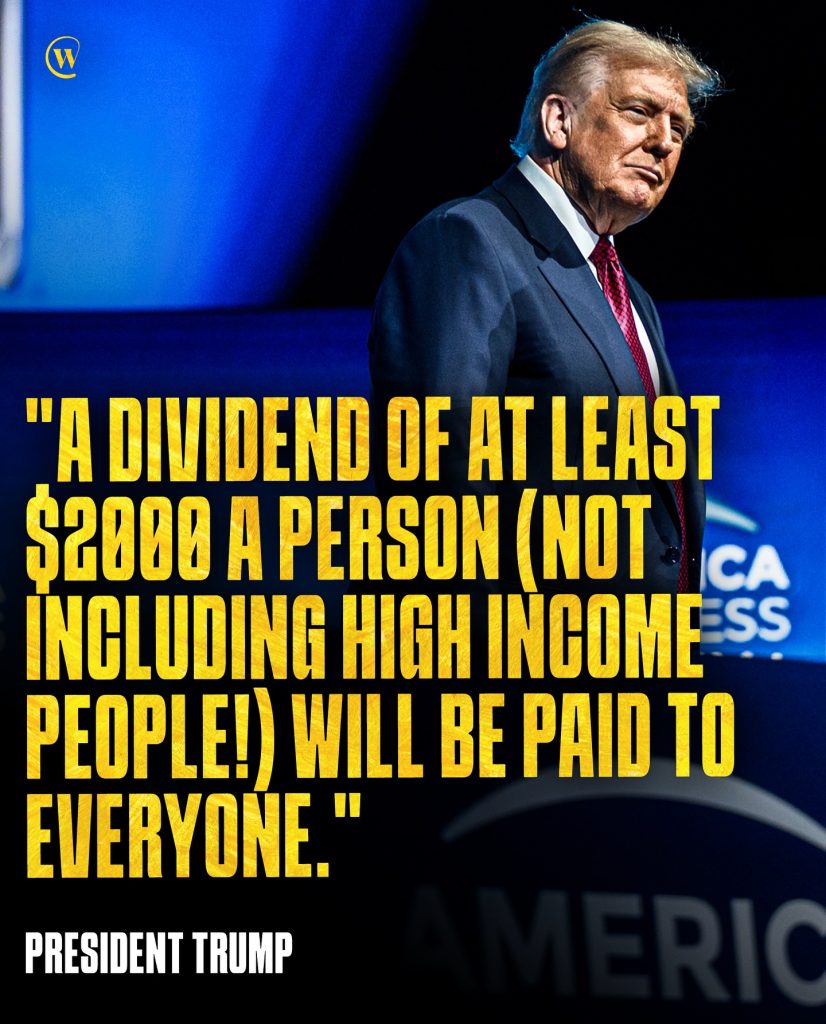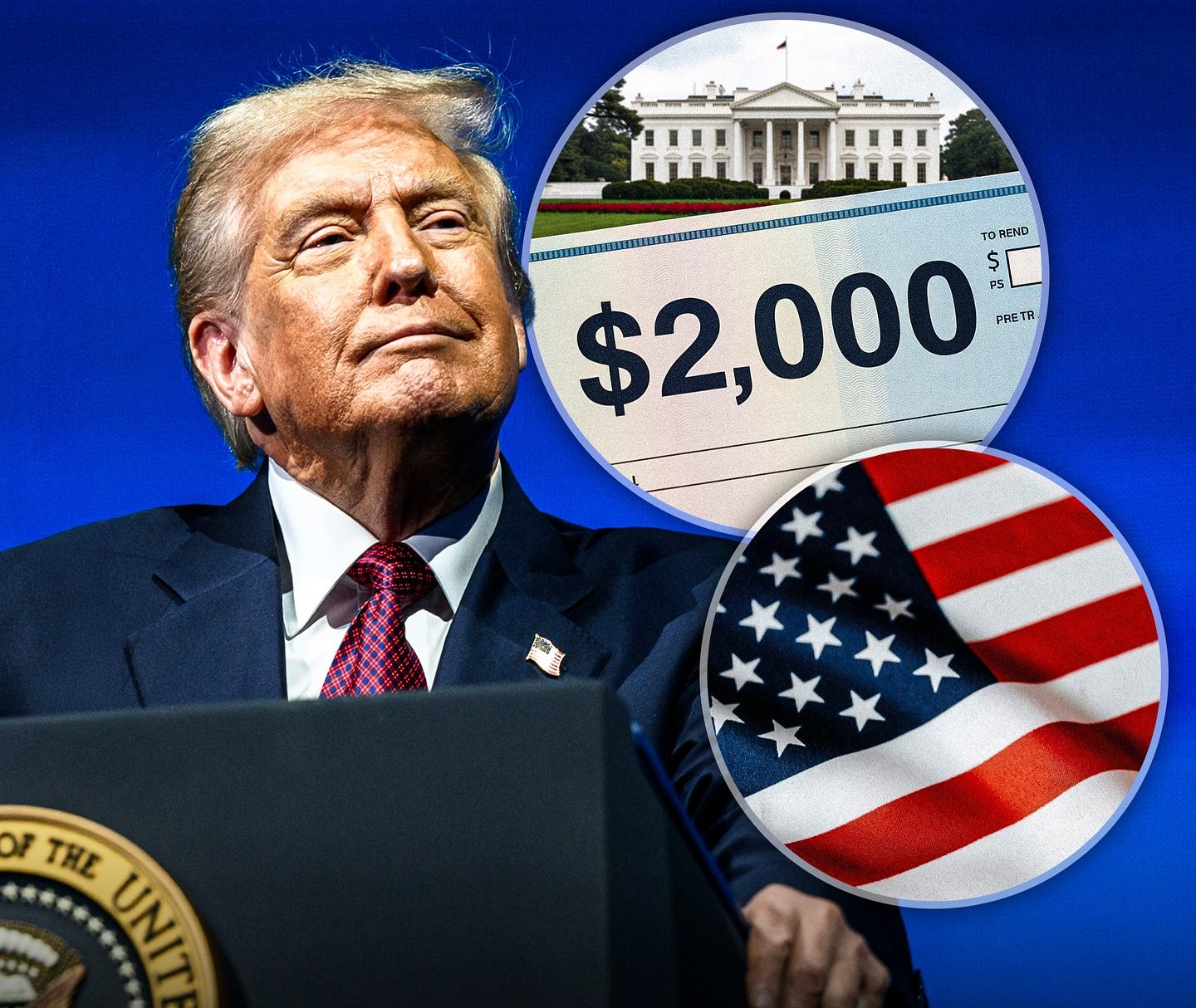President Trump Announces $2,000 “Tariff Dividend” for Most Americans, Claiming Trade Revenue Will Fund Direct Payments from $215 Billion in 2025 Tariff Receipts
In a surprise morning announcement that immediately sparked nationwide debate, former President Donald Trump said that most American citizens will receive a “tariff dividend” of at least $2,000, claiming the payments will be funded by record-high federal revenue from customs duties. The declaration, posted Sunday morning on Trump’s Truth Social account, quickly dominated both political and financial discussions as analysts rushed to assess the scope, feasibility, and potential impact of what could become one of the most unorthodox fiscal proposals in recent U.S. history.

“A dividend of at least $2,000 a person (not including high-income people!) will be paid to everyone,” Trump wrote, adding that the plan would return the benefits of trade policy “directly to the American people.” His statement did not include specific details such as income thresholds, eligibility rules, or timing for the potential payments. However, Trump emphasized that the funding source would come entirely from tariffs collected during fiscal year 2025, which the U.S. Treasury Department recently reported to have reached roughly $215 billion — an all-time record for customs duties.
According to Treasury data, that figure marks a sharp increase from pre-pandemic years, when annual tariff revenue averaged between $35 billion and $80 billion. Much of that surge stems from the trade measures introduced during Trump’s first term, which placed duties on a broad range of imports, particularly from China, as part of a strategy to encourage domestic manufacturing and penalize foreign producers accused of unfair competition. If applied evenly across eligible adults, the $215 billion in collected duties could indeed cover direct payments near the $2,000 level — though implementing such a transfer would require significant administrative coordination and congressional authorization.
Trump’s message struck a populist tone, echoing elements of both his economic nationalism and his earlier pandemic-era stimulus efforts. “The American people have been the ones paying for broken trade deals for decades,” he wrote. “Now they’ll finally see the rewards — not Wall Street, not foreign governments — but the hardworking men and women who make this country great.”

The post drew immediate attention from both supporters and critics. Among Trump’s backers, the idea was hailed as a creative way to turn trade policy into tangible household relief. Many pointed to the former president’s repeated argument that tariffs ultimately strengthen the nation’s position by generating domestic revenue, rather than burdening taxpayers directly. His campaign aides framed the announcement as part of a broader economic strategy aimed at “restoring wealth to the American middle class.”
For others, however, the proposal raised concerns about its economic implications. Economists and fiscal policy experts noted that while the government does collect billions in tariffs, those revenues are often offset by the higher import prices consumers and businesses pay as a result. “A $2,000 check sounds appealing,” said one senior trade analyst, “but the reality is that tariffs are taxes. Americans already pay for them indirectly through higher costs on everyday goods — from electronics to groceries. Returning that money as a dividend doesn’t erase the underlying inflationary impact.”
Still, the concept of a “tariff dividend” is politically powerful, blending the familiarity of a stimulus payment with Trump’s signature “America First” messaging. It also arrives at a moment when voters across the political spectrum are feeling the strain of persistent inflation, rising energy costs, and housing pressures. The promise of direct cash relief — particularly one framed as coming from trade policy rather than government debt — could resonate strongly in key swing states where economic anxiety remains high.
If enacted, the plan would mark an unprecedented mechanism for distributing tariff revenue directly to citizens. Historically, such funds have flowed into the general Treasury pool, helping to finance federal spending across various departments. There is no modern precedent for routing customs receipts into individual payments, though Alaska’s Permanent Fund — which distributes annual dividends from state oil revenues — offers a distant parallel. Trump’s allies were quick to make the comparison, arguing that just as Alaskans receive a share of their natural resource wealth, all Americans should benefit from the nation’s trade earnings.
The Treasury Department has not commented on Trump’s statement, nor has it indicated whether any official proposal is under review. However, sources familiar with the matter said the $215 billion figure cited in his post aligns closely with the most recent federal estimates. Those revenues reflect a combination of duties on consumer imports, industrial goods, and targeted sectors such as steel, aluminum, and semiconductors — many of which have been maintained or adjusted under the Biden administration.
Analysts say Trump’s framing of the revenue as a “dividend” rather than a “stimulus” is deliberate. It signals an attempt to differentiate his economic plan from previous pandemic relief efforts while positioning tariffs as a sustainable source of citizen benefit. In his Truth Social message, Trump made clear that high-income Americans would be excluded, implying a targeted distribution meant to favor low- and middle-income households. “This is not a giveaway,” he wrote. “It’s a return — a return of wealth to those who deserve it.”
Reaction from Washington has been divided along familiar partisan lines. Supporters within Trump’s political circle praised the idea as innovative and patriotic, while opponents dismissed it as populist theatrics without a viable path to implementation. “It’s an interesting soundbite but not an actual policy,” one former Treasury official said. “The logistics of identifying eligible recipients, calculating disbursements, and integrating tariff accounts into a payment system would require months — if not legislation.”
Financial markets reacted cautiously but without significant volatility. The dollar held steady in early trading, while U.S. Treasury yields showed little movement. Some analysts suggested that investors were treating the statement more as a campaign proposal than an imminent policy shift. Still, the announcement fueled widespread discussion across social media, with “Tariff Dividend” trending on X (formerly Twitter) and Facebook within hours.
For Trump’s supporters, the optics of the proposal play as much of a role as its economics. The image of a $2,000 check funded by tariffs — effectively framed as reclaiming wealth from foreign competitors — fits neatly into his long-standing narrative of American self-reliance and global toughness. “He’s taking care of the people, not the politicians,” one supporter wrote online. “Finally, we’re getting something back from all these trade wars.”
Economists remain divided on the broader consequences of such a program. Some argue that returning tariff revenue directly to consumers could, in theory, offset the regressive effects of import taxes, which tend to hit lower-income households hardest. Others warn that the approach risks turning trade policy into a populist tool for short-term political gain. “The fundamental issue is sustainability,” said an international trade expert. “Tariff income fluctuates based on global demand, trade volumes, and diplomatic relations. You can’t build a consistent fiscal policy on something that changes with every trade dispute.”
Still, the plan’s symbolism carries undeniable weight. Tariffs were central to Trump’s first-term agenda and remain one of the defining pillars of his economic identity. His campaign has repeatedly promised to expand and recalibrate those measures if he returns to office, suggesting that tariffs could become not just a tool of trade enforcement but a direct funding source for domestic programs.
According to his aides, the “tariff dividend” concept is part of a larger push to redefine how Americans think about international commerce — portraying tariffs not as punitive taxes but as revenue streams that reward national loyalty. The idea draws from Trump’s broader narrative of economic nationalism, in which global trade is reframed as a zero-sum contest between nations. “He’s saying, ‘If we’re going to fight for better deals, Americans should feel the benefit directly,’” explained a campaign strategist familiar with the discussions.
The scale of the proposed payments, however, would require complex coordination between multiple federal agencies, including the Treasury, the IRS, and the U.S. Customs and Border Protection. Assuming 90 percent of American adults qualify, the program would distribute more than $400 billion if it included dependents, suggesting either a narrower eligibility pool or phased rollout. For now, the plan remains a statement of intent rather than a formal policy blueprint.
What stands out most is the timing. With the 2026 election cycle on the horizon and economic pressures shaping voter sentiment, Trump’s message taps into the potent combination of fiscal populism and direct relief that has defined modern political communication. Whether viewed as campaign strategy or economic vision, it underscores his continued ability to dominate the national conversation with a single post.
For millions of Americans still grappling with inflation and economic uncertainty, the idea of a $2,000 check is immediately appealing. Yet, as economists have long noted, the real test of any proposal lies not in its promise but in its execution. If implemented, the “tariff dividend” would represent a bold experiment in redistributive trade policy — one that could reshape how the nation understands the intersection between global markets and personal prosperity.
As of Sunday evening, no official legislation or executive action had been introduced. But the ripple effects of Trump’s statement continue to spread — through markets, through newsrooms, and through households where the promise of $2,000 feels both distant and suddenly, once again, imaginable.

